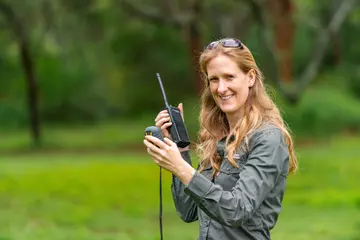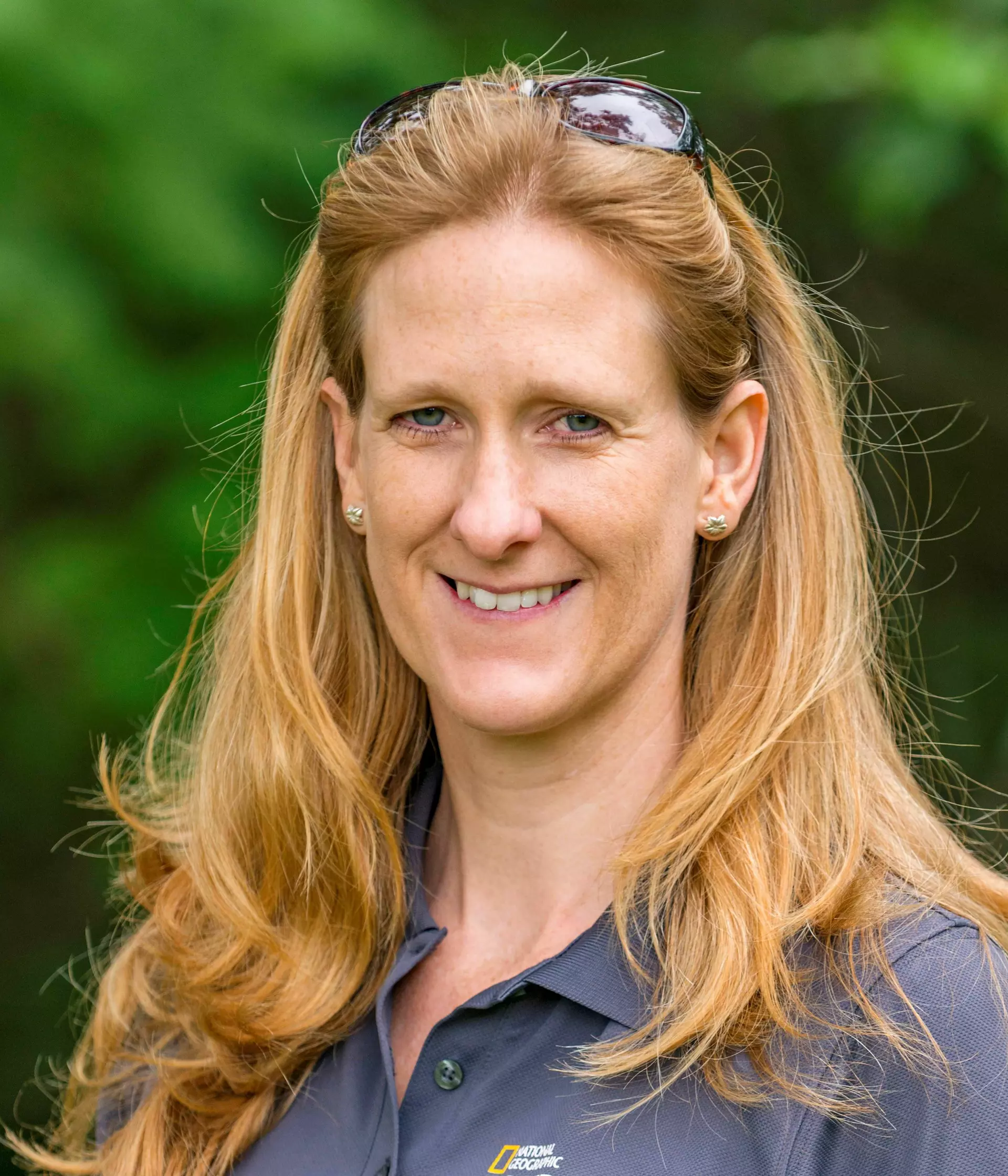
Community-based conservation
Landscape ecology
Institute of Zoology
Zoological Society of London
London
NW 14RY
United Kingdom
There are only approximately 7,000 cheetah left in the wild, and numbers are declining.
As a low density, wide-ranging species they depend on vast interconnected landscapes, which often span multiple countries. The work of the Africa Range-Wide Cheetah Conservation Initiative (CCI) (formerly Range Wide Conservation Program for Cheetah and African Wild Dogs) aims to support governments of all cheetah range states across Africa to develop and implement regional strategies and national conservation action plans to protect the species at the scale necessary for long-term population viability.

Read more about the Cheetah Conservation Initiative
2013-present: Southern African Coordinator; Africa Range-Wide Cheetah Conservation Initiative (formerly Range Wide Conservation Program for Cheetah and African Wild Dogs)
Comley, J., Wijers, M., Leslie, A.J., Groom, R.J. & Watermeyer J.P. (2023) Finding a safe space: Denning range dynamics of African wild dogs in Zimbabwe. Afr J Ecol. 2023;00:1–12. DOI: 10.1111/aje.13140
de Lorm, T. A., Horswill, C., Rabaiotti, D., Ewers, R. M., Groom, R. J., Watermeyer, J., & Woodroffe, R. (2023). Optimizing the automated recognition of individual animals to support population monitoring. Ecology and Evolution, 13, e10260. https://doi.org/10.1002/ece3.10260
Groom, R.J., Comley, J., Rabaiotti, D., Wolton, A., Jackson, C. & Watermeyer, J. (2022). African Wild Dog Reproductive Capabilities Revisited: Successfully Raising Three Litters in Less than 14 Months is Possible. African Journal of Wildlife Research, 52(1) : 44-60 https://doi.org/10.3957/056.052.0044
Tensen L., Jansen van Vuuren B., Groom R.J., Bertola L. D., de Iongh H., Rasmussen G., Du Plessis C., Davies-Mostert H., van der Merwe D., Fabiano E., Lages F., Rocha F., Monterroso P., Godinho R. (2022). Spatial genetic patterns in African wild dogs reveal signs of effective dispersal across southern Africa. Frontiers in Ecology and Evolution, v10. Doi:10.3389/fevo.2022.992389
Durant SM, Marino A, Linnell JDC, Oriol-Cotterill A, Dloniak S, Dolrenry S, Funston P, Groom R.J., Hanssen L, Horgan J, Ikanda D, Ipavec A, Kissui B, Lichtenfeld L, McNutt JW, Mitchell N, Naro E, Samna A and Yirga G (2022) Fostering Coexistence Between People and Large Carnivores in Africa: Using a Theory of Change to Identify Pathways to Impact and Their Underlying Assumptions. Frontiers in Conservation Science 2:698631. doi: 10.3389/fcosc.2021.698631
Becker et al (2022). Guidelines for evaluating the conservation value of African lion (Panthera leo) translocations. Frontiers in Conservation Science. https://doi.org/10.3389/fcosc.2022.963961
Elizalde Castells, D., Fernandes Elizalde, S.R.F., Ceriaco, L.M.P. & Groom, R.J. (2021). Ansorge’s cusimanse in Angola: 100 years apart, new records contribute to the species known range. Mammalia https://doi.org/10.1515/mammalia-2020-0091
Rabaiotti, D., Groom, R.J, McNutt, J. W., Watermeyer, J., O’Neill, H. M. K., & Woodroffe, R. (2021). High temperatures and human pressures interact to influence mortality in an African carnivore. Ecology and Evolution, 11(13), 8495-8506. doi:10.1002/ece3.7601
Elizalde, SRFF., Elizalde Castells, D., de Freitas NMCN., Groom, R.J. & Durant, S.M. (2020). Several black servals from a single survey at the Luando Strict Nature Reserve, Angola. African Journal of Ecology; 00:1–4. https://doi.org/10.1111/aje.12766
Overton J. Mc.C., Elizalde Castells, D., Figueira Fernandes Elizalde, S.R., Valério, H.M., Alexandre Zumbo, M., Groom, R.J. & Durant, S.M. (2020). Endangered African Wild Dogs (Lycaon pictus Temm.) in Angola: Filling a 50-year gap of knowledge with findings from two National Parks. African Journal of Ecology; https://doi.org/10.1111/aje.12715
McNutt, J.W., Groom, R.J. & Woodroffe, R. (2019) Ambient temperature provides an adaptive explanation for seasonal reproduction in a tropical mammal. Journal of Zoology, 309 (3), 153-160; doi:10.1111/jzo.12712
Durant, S.M., Mitchell, N., Groom, R.J., Ipavec, A., Woodroffe, R., Breitenmoser, C. & Hunter, L.T.B (2018) The Conservation Status of the Cheetah. In: Cheetahs: Biology and Conservation. Eds: Marker, L., Boast, L.K. and Schmidt-Küntzel, A. San Diego, Elsevier. Pp. 543-548.
Tensen, L., Groom, R.J., Khuzwayo, J. & Jansen van Vuuren, B. (2018) The genetic tale of a recovering lion population (Panthera leo) in the Savé Valley region (Zimbabwe): A better understanding of the history and managing the future. PLoS ONE 13(2): e0190369. https://doi.org/10.1371/journal.pone.0190369
Durant, S., Mitchell, N., Groom, R.J. et al (2017) The global decline of cheetahs and what it means for conservation. Proceedings of the National Academy of Sciences, 114, 528-533. DOI: 10.1073/pnas.1611122114
Weise, F.J., Vijay, V., Jacobson, A.P., Schoonover, R.F., Groom, R.J. et al. (2017) The distribution and numbers of cheetah (Acinonyx jubatus) in southern Africa. PeerJ 5:e4096; DOI 10.7717/peerj.4096
Woodroffe, R., Groom, R.J. & McNutt, J.W. (2017) Hot dogs: high temperatures impact reproductive success in a tropical carnivore. Journal of Animal Ecology, 1-10 https://doi.org/10.1111/1365-2656.12719
Jackson, C.R., Groom, R.J., Jordan, N.R. & McNutt, J.W. (2017). The effect of relatedness and pack size on territory overlap in African wild dogs. Movement Ecology DOI 10.1186/s40462-017-0099-8
Tensen, L., Groom, R.J., van Belkom, J., Davies-Mostert, H., Marnewick, K. & van Vuuren, B. (2016). Genetic diversity and spatial genetic structure of African wild dogs (Lycaon pictus) in the Greater Limpopo Transfrontier Conservation Area. Conservation Genetics 17(4) 785-794.
van der Merwe V, Marnewick K, Bissett C, Groom R.J., Mills MGL, Durant S.M. (2016). A conservation assessment of Acinonyx jubatus. In Child MF, Roxburgh L, Do Linh San E, Raimondo D, Davies-Mostert HT, editors. The Red List of Mammals of South Africa, Swaziland and Lesotho. South African National Biodiversity Institute and Endangered Wildlife Trust, South Africa.
Groom, R.J., Durant, S. & Breitenmoser-Würsten, C. (2016). Review of the Conservation Strategy for cheetah and African wild dog in southern Africa. CAT News 63, 39-41.
Mbizah, M., Steenkamp, G. & Groom, R.J. (2016). Evaluation of the Applicability of Different Age Determination Methods for Estimating Age of the Endangered African Wild Dog (Lycaon Pictus). PLOS ONE, DOI:10.1371
Groom, R. J., Lannas, K. and Jackson, C. R. (2016). The impact of lions on the demography and ecology of endangered African wild dogs. Animal Conservation DOI:10.1111/acv.12328
Durant, S., Mitchell, N., Ipavec, A. and Groom, R.J. (2015) Acinonyx jubatus. The IUCN Red List of Threatened Species 2015: e.T219A50649567.
Groom, R.J., Funston, P.J., Mandisodza, R. (2014). Surveys of lions Panthera leo in protected areas in Zimbabwe yield disturbing results: what is driving the population collapse? Oryx, 48 (3), 385-393.
Mbizah, M, Joubert, C.J., Joubert, L. & Groom, R.J. (2014) Implications of African wild dog (Lycaon pictus) denning on the density and distribution of a key prey species: addressing myths and misperceptions. Biodiversity and Conservation: 23 (6), 1441-1451.
Jackson, C., Power, R.J., Groom, R.J., Masenga, E.H., Mjingo, E.E, Røskaft, E & Davies-Mostert H (2014). Heading for the hills: risk avoidance drives den site selection in African wild dogs. PLoS One 9(6) e99686
Groom, R.J., Gandiwa, E., Gandiwa, P. & van der Westhuizen, H.J. (2013). A mass poisoning of white-backed and lappet-faced vultures in Gonarezhou National Park. Honeyguide, 59 (1) 5-9.
Groom, R.J. & Western, D.W (2013). Impact of land subdivision and sedentarization on wildlife in Kenya’s southern rangelands. Rangeland Ecology & Management 66, 1-9.
Funston, P.J., Groom R.J. & Lindsey, P.A. (2013). Insights into the management of large carnivores for profitable wildlife-based land uses in African Savannas. PLoS One 8(3) e59044
Packer et al (2013). Conserving large carnivores: dollar and fence, Ecology Letters, 16, 635-641.
Riggio, J., Jacobson, A., Dollar, L., Bauer, H., Becker, M., Dickman, A., Funston, P., Groom, R.J, Henschel, P., de Iongh, H., Lichtenfield, L., & Pimm, S. (2013) The size of savannah Africa: a lion’s view. Biodiversity & Conservation¸ 22, 17-35.
Mbizah, M.M., Marino, J. & Groom R.J. (2012). Diet of four sympatric carnivores in Savé Valley Conservancy, Zimbabwe: implications for conservation of the African wild dog (Lycaon pictus). Sth Afr J. Wildl Res, 42, 94-103.
Davies-Mostert, H.T., Kamler, J.F., Mills, M.G.L., Jackson, C., Rasmussen, G., Groom, R.J. & Macdonald, D.W. (2012). Long distance dispersal of African wild dogs among protected areas in southern Africa. Afr J Ecol, 50, 500–506
Marsden, C.D., Woodroffe, R., Mills, M.G.L., McNutt, J.W., Creel, S., Groom, R.J., Emmanuel, M., Cleaveland, S., Kat, P.W., Rasmussen, G., Ginsberg, J., Lines, R., Andre, J.M., Begg, C., Wayne, R.K. & Mable, B.K. (2012) Spatial and temporal patterns of neutral and adaptive genetic variation in the endangered African wild dog (Lycaon pictus). Molecular Ecology, 21 (6):1379-1393.
Lindsey, P., Romanach S., Tambling, C., Chartier, K., & Groom, R.J. (2010) Ecological and financial impacts of illegal bushmeat trade in Zimbabwe. Oryx, 45 (1) 96-111
Maclennan S., Groom R.J., Macdonald D. & Frank L. (2009) Evaluation of a compensation scheme to bring about pastoral tolerance of lions. Biological Conservation, 142 (11) 2419-2427
Western, D., Groom R.J. & Worden J. (2009) The impact of subdivision and sedentarization of pastoral lands on wildlife in an African savanna ecosystem. Biological Conservation, 142 (11) 2538-2546
Groom R.J. & Harris S. (2009) Factors affecting the distribution patterns of zebra and wildebeest in a resource-stressed environment. African Journal of Ecology, 48, 159-168.
Groom R.J. & Harris S. (2008) Conservation on community lands; the importance of equitable revenue sharing. Environmental Conservation, 35 (3) 242-251
